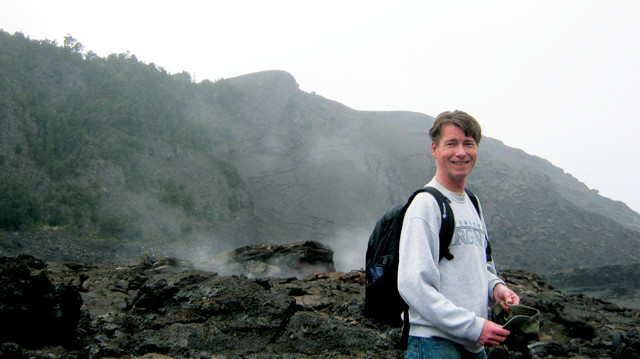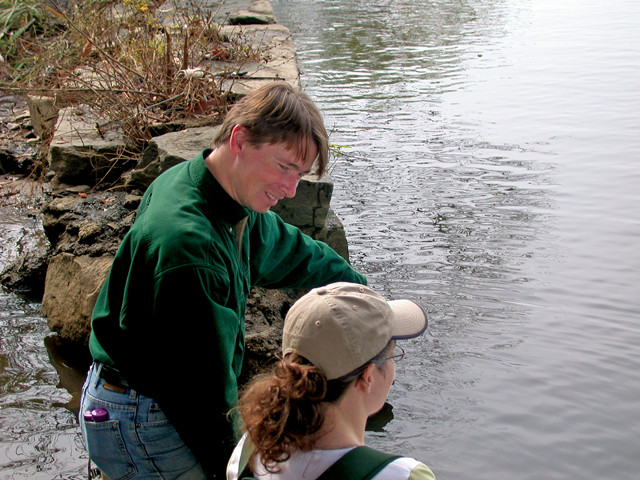
by Bethany Augliere Friday, May 19, 2017

Biogeochemist Stephen MacAvoy is an assistant professor and chair of the environmental science department at American University in Washington, D.C. Credit: Stephen MacAvoy.
When Stephen MacAvoy was growing up in the suburbs of Connecticut, most of the animals he encountered were pets: dogs, cats or the occasional bird. But on his annual family trips to the coast of North Carolina, the beach provided a window into an alien world. He collected washed-up blue crabs, snails and other marine organisms, with their intriguing shapes, spines and intricate mouthparts. His mother, a nursing professor, and his father, a business consultant, even allowed MacAvoy to bring his field samples home in a cooler.
When it came time to pick a major at Fairfield University in Connecticut, the choice was obvious: biology. In his last year as an undergraduate, he got his first taste of research, working with a marine biologist to examine oyster hemolymph disease in Long Island Sound.
Later, MacAvoy’s doctoral work in biogeochemistry at the University of Virginia focused on how animals move nutrients through aquatic systems. Now, as an associate professor and chair of the environmental science department at American University in Washington, D.C., MacAvoy specializes in the urban environment found in his own backyard, studying urban water problems like stormwater overflow, which contributes to sewage and nutrient pollution, and the geochemistry of the degraded Anacostia River.
MacAvoy recently spoke with EARTH about how living “green” roofs can help reduce pollution in waterways, his surprising love of teaching and his advice for young scientists.
BA: What are some of the issues that face the Anacostia River?
SM: The river is contaminated with chemicals from industries that are largely absent now, but the chemicals persist. Polycyclic aromatic hydrocarbons from combustion engines still accumulate.
E. coli and pathogenic bacteria abound in the river. The river should be relatively clear, free of bacteria, and have low nitrate levels, but we see fish with heavy-metal accumulations or cancer.
Additionally, runoff can overwhelm the stormwater drainage system and, when that happens, the water mixes with sewage. There are 53 spots in D.C. where this happens and it can be tripped by as little as a quarter of a centimeter of rain. In certain places, you’ll see signs along the waterfront that say, “Danger: combined sewage outflow pipe here,” and there’s a pipe going out into the middle of the Potomac River. And then you look up and see people paddle-boarding out over the sewage outflow.
D.C. has a plan to make the Anacostia River fishable and swimmable by 2032.The city is serious about it. But if they are going to clean up the Anacostia, they need to take care of the stormwater problem.
BA: What have you discovered about the geochemistry of the Anacostia River?
SM: I’ve been examining different chemical aspects of the Anacostia River for about eight years. The latest thing that’s piqued my interest is calcium levels, which are very high. While the pH of the rainwater here is 4.9 [acidic], the pH of the river is between 7.5 and 8 [basic]. There is twice as much calcium and magnesium in the Anacostia than should be here given the type of bedrock, which is siliceous, not carbonaceous. So, I wondered why that would happen.
I think it is related to concrete in the city — which is essentially artificial limestone. At some point between when the rain falls and when it drains into the river, it gets buffered. We don’t have an acid rain problem in D.C, as far as rivers are concerned, and I suspect it’s because the infrastructure, rather than soil, is buffering acidity and releasing calcium.
BA: What does more calcium mean for the environment?
SM: The water is getting saltier because of the extra ions, not just calcium but also magnesium, sodium and potassium. That might stress aquatic life. Then again, studies have shown that some fish do better … in freshwater with higher ionic strength. So, we have to dig into this more.
BA: What was the focus of your research on green roofs on which vegetation is grown?
SM: Given that D.C. has this pollution reduction goal, green roofs can not only help the urban water problem by retaining water, but also potentially reduce the [runoff of] nitrogen and suspended solids [organic and inorganic particles larger than 2 microns that contribute to water pollution]. I wanted to get some quantitative data to figure out what exactly these roofs are doing.
The goal was to learn how much nitrogen and suspended solids would be retained by these green roof systems per square foot, given a certain amount of rainfall. We also measured total phosphorus and dissolved organic carbon. To do that, I looked at rainwater coming in, the water flowing through the roof and the runoff exiting — pretty simple.
BA: Do the roofs work?
SM: We found that, over 16 months and nine storm events monitored, the green roofs reduced suspended solids by up to 83 percent and reduced nitrate by up to 32 percent, relative to untreated runoff. So, they have an impact. Given that suspended solids are the major urban pollutant, the fact that these roofs take up suspended solids is a big deal — and the roofs are cheap.
reen roofs are a great way to artificially create green space without knocking buildings down, planting trees and making soil. Converting land into greenery that way is really expensive. But putting green roofs atop buildings gives you the functionality of green space without needing to dismantle the building. If 10 percent of roofs in D.C. had green roofs, we’d go a long way toward solving our urban water problem.

MacAvoy sampling the Anacostia River from the Navy Yard. Credit: Kenneth Jensen.
BA: Why do you like to work in urban environments?
SM: One of my field sites is actually a stream that runs through my neighborhood park, so it really is in my backyard! Because the environment I’m studying is my own, there is a certain satisfaction — and alarm, in some cases — from working there.
I also enjoy studying impacted systems, as opposed to pristine systems, because you get to investigate how their function might have changed, and how to improve things. We will not be able to make urban or suburban systems pristine again even if we wanted to. It will be important for the future to try to restore the function of systems even if you can’t make them “natural” again. So making altered systems functional is an important next step.
BA: What has been your favorite research project?
SM: The deep-sea work I did years ago was like going on trips to the moon. We were looking at chemosynthetic production around cold vents in the Gulf of Mexico off the coast of Louisiana that were up to a kilometer and a half deep. It’s the only work I’ve been a part of that made it into textbooks.
The traditional model of what fuels the ocean is that the tiny plankton in the thin sunlit layer right at the surface — the first 50 meters or so, depending on the ocean — produce all the sugar that then fuels the entire ocean. So anything living down at depth has to depend on these plankton. We thought, “Well, what if that weren’t the case?” We wanted to know if the chemosynthetic production [near the seeps] was getting into the surrounding benthos.
We collected predators both near and far from known cold hydrocarbon seeps. Because carbon isotope ratios are different when produced by chemosynthesis, rather than photosynthesis, we could search for those isotopic signatures in the predators.
We found that predators like spider crabs and hagfish captured 2 kilometers from areas of known seepage could derive up to 20 percent of their carbon or sulfur from chemosynthetic primary production versus photosynthetic primary production. We don’t know how widespread these cold hydrocarbon seeps are, but the potential importance is that the productivity of the oceans might be substantially higher than we have traditionally thought.
BA: You’ve won several awards for teaching. Did you always know you wanted to teach?__
SM: No, but I’ve found to my surprise that teaching is more rewarding than research. I didn’t start teaching until I came to American University and now I’ve taught 17 different classes.
You can really change how a student views the world. I’ve seen it many times. The “lightbulb” that cartoonists draw is real. Those students will carry a memory of being inspired with them for the rest of their lives, and that is a big deal. If I write a great paper for a good journal, it might be cited a few hundred times or make it into a textbook. That’s great, and I enjoy the discovery very much, but it doesn’t have much of an impact. If you enhance someone’s life experience, you’ve changed the world.

Some of MacAvoy's American University students researching urban river environments. Credit: both: Stephen MacAvoy.
BA: Any interesting stories from your time with students in the field?
SM: Aside from eating our lunch next to raw sewage or getting stopped by police? [laughs] Well, we are an urban campus, so many of my students have spent little time outside in nature. They didn’t grow up exploring the woods. One time, I had two undergraduate students working with me at a freshwater swamp site in Virginia. One student ended up walking into the mud and sinking. We had to pull her out with a rope; she was completely covered in mud and had to leave her waders behind. I remember her yelling at me, “MacAvoy, what have you gotten me into?!” That was kind of funny.
BA: Do you have a lesson that you try to impart to your students?
SM: I try to teach my students never to take anything at face value — dig, dig, dig and be critical.
BA: What is your advice for emerging scientists?
SM: Two things, perhaps. One, find something that you are really passionate about and follow it. Don’t let anyone tell you that you shouldn’t. The worst thing in the world would be to find yourself in a career at 40 years old wondering what you’re doing. That won’t happen to you if you follow your passion. So, don’t listen to people who say you have to follow the money or you have to compromise your interests. And two is to be patient. A career in science takes a long time [to develop], but you’ll get there eventually. So, enjoy the journey.
© 2008-2021. All rights reserved. Any copying, redistribution or retransmission of any of the contents of this service without the expressed written permission of the American Geosciences Institute is expressly prohibited. Click here for all copyright requests.